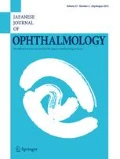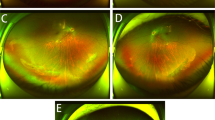Abstract
Purpose
To investigate the relationship between the size of the peripapillary crescent and different ocular parameters in highly myopic healthy eyes; in addition, to determine whether the area of the peripapillary crescent enlarged significantly during one year of observation.
Methods
The medical records of 49 highly myopic healthy eyes whose fellow eyes had myopic complications were reviewed. The area of the peripapillary crescent and other ocular parameters were measured initially and after one year. The changes in the area of the peripapillary crescent and their association with other ocular parameters during the natural course of the pathological myopia were determined.
Results
The area of the peripapillary crescent was significantly associated with the choroidal thickness (P < 0.001), axial length (P < 0.001), and foveal thickness (P < 0.01). Stepwise regression analyses found that the factors most associated with the area of the peripapillary crescent were the choroidal thickness (P < 0.01) and the absolute nasal staphyloma height (P < 0.05). The factor most associated with the increase in the area of the peripapillary crescent was the increase in the axial length (P < 0.01).
Conclusions
The size of the peripapillary crescent may be affected by changes in the axial length, the height of the posterior staphyloma, and the choroidal thickness.



Similar content being viewed by others
References
Curtin BJ, Karlin DB. Axial length measurements and fundus changes of the myopic eye. Am J Ophthalmol. 1971;71:42–53.
Fujiwara T, Imamura Y, Margolis R, Slakter JS, Spaide RF. Enhanced depth imaging optical coherence tomography of the choroid in highly myopic eyes. Am J Ophthalmol. 2009;148:445–50.
Duke-Elder S, Abrams D. Changes at the optic disc. Pathological myopia. In: Duke-Elder S, editor. System of ophthalmology, ophthalmic optics and refraction, vol V. London: Henry Kimpton. 1970. p. 300–62.
Takahashi A, Ito Y, Iguchi Y, Yasuma TR, Ishikawa K, Terasaki H. Axial length increases and related changes in highly myopic normal eyes with myopic complications in fellow eyes. Retina. 2012;32:127–33.
Nagaoka N, Oh-no-Matui K, Saka N, Tokoro T, Mochizuki M. Clinical characteristics of patients with congenital high myopia. Jpn J Ophthalmol. 2011;55:7–10.
Yasuzumi K, Ohno-Matsui K, Yoshida T, Kojima A, Shimada N, Futagami S, et al. Peripapillary crescent enlargement in highly myopic eyes evaluated by fluorescein and indocyanine angiography. Br J Ophthalmol. 2003;87:1088–90.
Chui TY, Zhong Z, Burns SA. The relationship between peripapillary crescent and axial length: implications for differential eye growth. Vision Res. 2011;51:2132–8.
Nakazawa M, Kurotaki J, Ruike H. Longterm findings in peripapillary crescent formation in eyes with mild or moderate myopia. Acta Ophthalmol. 2008;86:626–9.
Curtin BJ. The posterior staphyloma of pathologic myopia. Trans Am Ophthalmol Soc. 1977;75:67–86.
Ikuno Y, Tano Y. Retinal and choroidal biometry in highly myopic eyes with spectral-domain optical coherence tomography. Invest Ophthalmol Vis Sci. 2009;50:3876–80.
Ikuno Y, Jo Y, Hamasaki T, Tano Y. Ocular risk factors for choroidal neovascularization in pathological myopia. Invest Ophthalmol Vis Sci. 2010;51:3721–5.
Suzuki Y, Iwase A, Araie M, Yamamoto T, Abe H, Shirato S, et al. Risk factors for open-angle glaucoma in a Japanese population: the Tajimi Study. Ophthalmology. 2006;113:1613–7.
Perera SA, Wong TY, Tay WT, Foster PJ, Saw SM, Aung T. Refractive error, axial dimensions, and primary open-angle glaucoma: the Singapore Malay Eye Study. Arch Ophthalmol. 2010;128:900–5.
Xu L, Wang Y, Wang S, Wang Y, Jonas JB. High myopia and glaucoma susceptibility. The Beijing Eye Study. Ophthalmology. 2007;114:216–20.
Leung CK, Mohamed S, Leung KS, Cheung CY, Chan SL, Cheng DK, et al. Retinal nerve fiber layer measurements in myopia: an optical coherence tomography study. Invest Ophthalmol Vis Sci. 2006;47:5171–6.
Sihota R, Sony P, Gupta V, Dada T, Singh R. Diagnostic capability of optical coherence tomography in evaluating the degree of glaucomatous retinal nerve fiber damage. Invest Ophthalmol Vis Sci. 2006;47:2006–10.
Kanno M, Nagasawa M, Suzuki M, Yamashita H. Peripapillary retinal nerve fiber layer thickness in normal Japanese eyes measured with optical coherence tomography. Jpn J Ophthalmol. 2011;54:36–42.
Ohno-Matsui K, Shimada N, Yasuzumi K, Hayashi K, Yoshida T, Kojima A, et al. Long-term development of significant visual field defects in highly myopic eyes. Am J Ophthalmol. 2011;152:256–65.
Acknowledgments
This work was supported by grants from the Scientific Research from the Ministry of Education, Culture, Sports, Science, and Technology of Japan (Dr Ito, C2159225).
Conflict of interest
The authors declare no conflict of interest.
Author information
Authors and Affiliations
Corresponding author
About this article
Cite this article
Takahashi, A., Ito, Y., Hayashi, M. et al. Peripapillary crescent and related factors in highly myopic healthy eyes. Jpn J Ophthalmol 57, 233–238 (2013). https://doi.org/10.1007/s10384-012-0224-6
Received:
Accepted:
Published:
Issue Date:
DOI: https://doi.org/10.1007/s10384-012-0224-6




